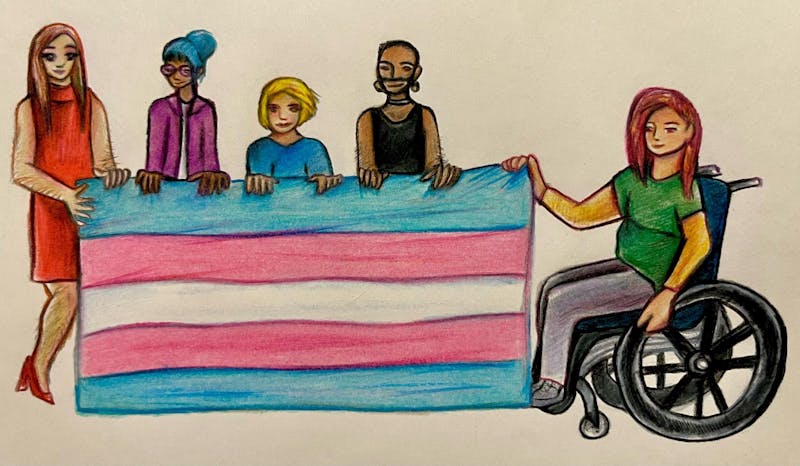

On Feb. 15, 2022, Assembly Bill 977 was introduced to the Wisconsin State Legislature by nine state representatives, and cosponsored by three state senators. Assembly Bill 977 proposed in the cold legal logic of political change that transgender and nonbinary kids under the age of 18 should be prohibited from any gender transition procedures and gender affirming medical care. Thankfully, this bill was left dead on the legislature floor March 15, but similar bills are on the rise across the country, including Missouri’s SB843, Tennessee's HB2835 and Arizona's HB2608. Gender affirming care, however, is critical for the health and livelihood of transgender youth.
Assembly Bill 977, and similar bills across the country, defines gender transition procedures as “any medical or surgical service provided or performed with the purpose of assisting an individual with a physical gender transition.” This is an incredibly broad set of procedures, ranging from cosmetic surgery to puberty blockers and hormone replacement therapy.
One of the most well known types of gender affirming care is hormone replacement therapy (HRT). HRT is a medical treatment that helps people match their physical appearance to their gender identity. A man who was assigned female at birth (AFAB) may pursue masculinizing HRT, while a woman assigned male at birth (AMAB) may pursue feminizing HRT. Nonbinary individuals — those whose gender identity is not inside the traditional gender binary — may choose to pursue feminizing or masculinizing HRT depending on their transition goals.
The methods and results of HRT vary greatly between individuals. For individuals seeking feminizing HRT, the process generally starts with taking medications such as Aldactone, which blocks the production of testosterone. Soon after, patients will be able to take estrogen to promote feminization, including redistribution of fat, decrease growth in facial and body hair, breast growth and decreased hair loss. Individuals seeking masculinization HRT go through a similar process, but generally do not have to take additional medication to block estrogen production. Patients will begin by taking testosterone, which can promote changes such as voice deepening, changing body fat distribution and facial hair growth.
This type of therapy is generally not prescribed to people under the age of 16. Instead, trans and nonbinary kids may opt to use pubertal blockers. Puberty is triggered by gonadotropin releasing hormones (GnRH), which originate from the hypothalamus. GnRH travels through tiny blood vessels in the brain to the pituitary gland, which produces either testosterone or estradiol and progesterone. During puberty, an individual’s GnRH levels are high as the body develops secondary sexual characteristics. Pubertal blockers act by inhibiting the production of GnRH, effectively stopping puberty from occurring.
Puberty blockers can be an important factor in an individual's transition. It allows for greater ease of social transition, such as changing one's name or pronouns, relieves gender dysphoria caused by puberty, and gives families time to plan for future transition goals and needs. Additionally, pubertal blockers do not permanently halt puberty. If an individual decides not to pursue hormonal transition or medical transition, GnRH production and puberty will continue when they stop taking pubertal blockers. If individuals do decide to pursue hormones or medical transition, the effects of HRT will allow for a pubertal experience similar to their cisgender peers. Pubertal blockers, while approved by the FDA and supported in the medical community, are not free of side effects. Short term side effects may include headaches, fatigue and changes in mood and weight. Long term side effects may include lower bone density, which can be mitigated through diet and nutrition, and delayed growth plate closure, leading to a slightly taller adult height. Overall, pubertal blockers are an impermanent gender affirming treatment to relieve dysphoria and increase quality of life.
The Trevor Projects National Survey on LGBTQ Youth Mental Health found that in 2021, over half the trans and non-binary respondents had seriously considered attempting suicide last year. In 2015, an observational study published in the National Library of Medicine found that 30% of transgender youth age 12-24 had attempted suicide at least once. Access to pubertal blockers and other gender affirming care, however, greatly decreases suicidal thoughts and attempts in trans youth. After one year of pubertal blockers or HRT, trans and nonbinary youths where 60% less likely to suffer from depression and 73% less likely to have suicidal thoughts. Additionally, this same study found that delaying treatment of pubertal blockers and HRT after prescription could cause a three time increase in suicidal thought and ideation in trans youth. Assembly Bill 977 is actively putting the lives of trans youth at risk by prohibiting gender affirming treatments.
With swaths of anti-trans legislation being proposed and signed across the country, it’s important now more than ever to support trans and nonbinary kids. Even something as simple as using someone's correct pronouns can have a monumental impact. On a broader level, we as individuals can donate to LGBTQ+ charities, call our representatives and voice our dissent and do what we can to make the lives of trans and nonbinary kids easier by listening to them, respecting them and giving them space to grow.